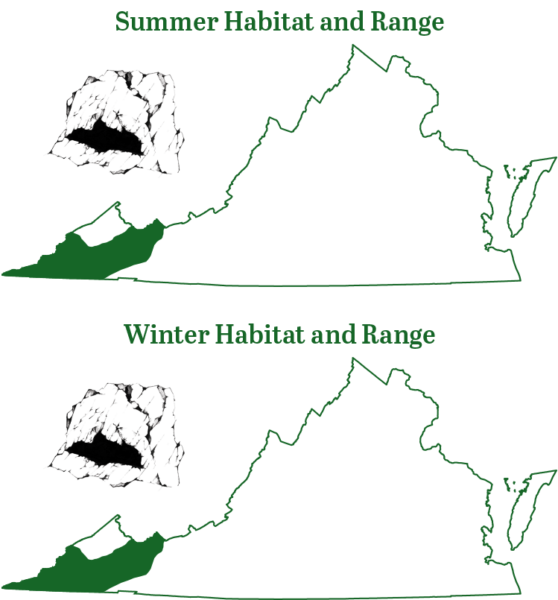Gray Bat. © Merlin D. Tuttle, Bat Conservation International.
Gray Bat. Illustration by Brittany Fernald.
Gray bat, wing attachment at the ankle.
Fact File
Scientific Name: Myotis grisescens
Classification: Mammal, Order Chiroptera
Conservation Status:
- Federally Endangered in the U.S.
- State Endangered in Virginia
- Species of Greatest Conservation Need-Tier 2a on the Virginia Wildlife Action Plan
Identifying Characteristics
The gray bat is found in the Tennessee Valley drainage in southwest Virginia. They weigh 0.3–0.38 ounces and measure 3.2–3.8 inches in length. Gray bats are easily distinguished from other members of the genus Myotis by the uniformly colored hairs on their backs. Gray bats possess one feature that no other Myotis in the United States has: the wing membrane is attached to the ankle as opposed to the side of the foot or the base of the toes.
Habitat
The gray bat and the Virginia big-eared bat are Virginia’s true cave bats as they use caves year round for both hibernacula and summer roosts. Females typically raise their young in a cave that often has a small stream running through it. Males will set up bachelor colonies with home ranges that encompass many caves.
Diet
Gray bats most frequently feed over large bodies of water such as lakes and rivers. They prey on moths, beetles, flies, mosquitoes, and mayflies along with many other species of insects.
Distribution:
Gray bats are predominately found in the summer months in Virginia, with the majority migrating out of state to hibernate in Tennessee.

Reproduction
Reproduction takes place in the fall during the swarming period around the hibernacula. A single young is born in late May or early June, and they become volant in approximately three weeks. Mothers leave their young hanging in the caves as they forage and are capable of distinguishing their young from the others when they return.
Conservation
Primary threat will be white-nose syndrome if gray bats are affected by the disease. Protection of winter and summer roosts are conservation priorities.
Last updated: August 14, 2024
ShopDWR
Order your copy of A Guide to the Bats of Virginia, along with more gear, guides, and gifts!
Visit ShopDWRThe Virginia Department of Wildlife Resources Species Profile Database serves as a repository of information for Virginia’s fish and wildlife species. The database is managed and curated by the Wildlife Information and Environmental Services (WIES) program. Species profile data, distribution information, and photography is generated by the Virginia Department of Wildlife Resources, State and Federal agencies, Collection Permittees, and other trusted partners. This product is not suitable for legal, engineering, or surveying use. The Virginia Department of Wildlife Resources does not accept responsibility for any missing data, inaccuracies, or other errors which may exist. In accordance with the terms of service for this product, you agree to this disclaimer.

